Hook and Irons
Fireman Jim Flynn September 08 2013, 8 Comments
On February 13, 1917 Fireman Jim Flynn entered the ring with a young up-and-comer Jack Dempsey. Jim Flynn who had passed the height of his career charged to the center of the ring and quickly sent the Manassa Mauler to ground with a devastating right. Twenty seconds later, Dempsey was still trying to find his feet. Here is an account of the knockout.
'With Dempsey still bent over and walking toward Flynn, both forearms and gloves covering his face, Flynn rushed again. The Pueblo battler gave Dempsey's head a quick shove toward his right and sent a short right hand hook through Dempsey's guard and straight to the point of the chin. (Salt Lake Telegram)
Dempsey was down 10 seconds in to the bout.'
That quick, embarrassing loss was the only time in Jack Dempsey's storied career (66-6-11) that the future champion was ever knocked out and it was the highlight of Jim Flynn's career, a fighter who 'fought them all' but never earned the heavyweight title. For a time, Fireman Jim Flynn was the best hope of defeating the feared Jack Johnson but was never able to best the 'Galveston Giant' in three tries. Jim Flynn was famous however for knocking out aspiring contenders with such neatness that he became known as the 'Destroyer of Hopes.' Jim Flynn ended his career with 47 wins, 41 losses, and 17 draws.
Early Life
Jim Flynn was born in Hoboken, NJ with name Andrew Chiariglione. He was actually of Irish-Italian descent, but took the name Jim Flynn for professional purposes as the Irish were some of the most devoted boxing fans at the time. When Flynn was a young man, the family moved to Pueblo, CO where he took up railroading and became a fireman for the Pueblo Fire Department and the Denver and Rio Grande Railroad. Jim Flynn remained with the fire service throughout most of his boxing career.
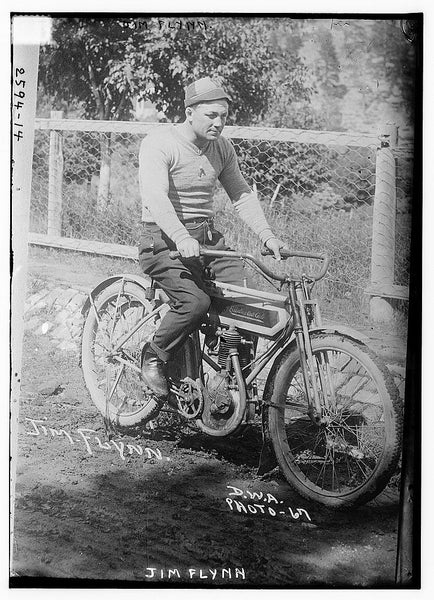
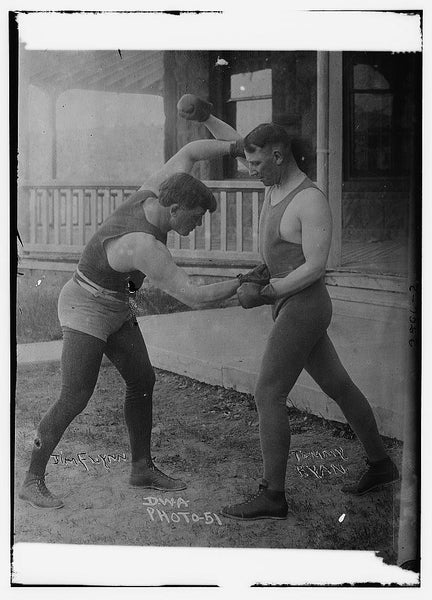



Inspiration
While researching ideas, the legendary knockout of Jack Dempsey, the Manassa Mauler combined with the workman-like boxing career of the underdog Jim Flynn inspired us to create a design honoring Flynn for Hook & Irons. Choosing the the designer was easy for this one. Steve Wolf specializes in hand-drawn art and works frequently with different sports topics. Additionally, he is a collector of vintage boxing artifacts and he seemed as excited, if not more, to bring this idea to life. As there is no poster for this event that we know of that still exists, we asked Steve to imagine a poster for the bout using the style of lettering and drawing that was popular at the time. We also asked him to draw his best rendition of Jim Flynn. The final design couldn't be more striking than the photo he worked from. We hope you enjoy the design and the small piece of history where the workman--the fireman--the boxer--the constant fighter--won one for the underdog.
The Bronx is Burning August 18 2013, 3 Comments
Hugh Halligan's Masterpiece Revisited November 28 2012, 9 Comments
When we created Hook & Irons Co. we came up with the Signature Line as way to pay homage to the parts of the fire service that are historically significant-- the parts of the fire service that so many of us feel passionately about. We brainstormed over so many things during those first days, but always, and without question, we were certain that we wanted to create a shirt honoring every fireman's favorite tool, the Halligan bar.

Hugh Halligan on right
Hugh Halligan is an icon of the fire service. With FDNY, he rose to the rank of Deputy Chief and is remembered as a 'fireman's fireman' working on many of the busiest companies in the city. But, he is known best for the tool he invented that is still carried on nearly every fire truck in America. While today's versions may have been refined a bit, and are now built by different manufacturers, they are very nearly the same exact tool that Halligan invented in the 1940's.
The original Halligan tool was made of cross-drop forged from one piece of No. 4140 (high carbon content) steel, and weighed 8 ½ lbs. This was a great improvement in strength and weight over its predecessors, The Claw and Kelly tool. The standard bar was approximately 30” in length, with a 15/16” shaft shaped into a hexagon for grip. The fork was a minimum of 6” long tapered into two well beveled tines. Spacing between the tines allows for a gas valve to be shut off. And stamped into the steel of the forks of the original Halligan tool was Hugh's signature and the letters AM + DG. Chief Halligan was a very religious man and it is widely believed the letters stood for the Latin phrase , Ad Majorem Dei Gloriam or “for the greater glory of God.” This phrase was a favorite of St. Ignatius of Loyola, founder of the Society of Jesus. Pope John Paul II routinely used it in his writings. He would print AMDG in the top left of every page he wrote. The + sign is widely believed to represent a cross.

When creating the shirt, it was important to us to include these elements into the design. We used the original advertisements as inspiration and we picked colors that we thought were as hard-looking as the drop-forged steel of the Halligan tool. The typography is chosen and inspired from the ad, as well as the slogan, "Yes! It is an Ugly Bar." The ribbon at the bottom of the shirt (also taken from the ad) represents the Boston Fire Department who was the first to recognize the genius of the tool and put one on every single truck in Boston.


The genius of the Halligan tool becomes apparent in the hands of a skilled operator and when properly used – provide protection to the arms, hands, and body of the holder during forcible entry operations. Pound for pound, it is the best tool on any rig and paired with a flat-headed axe, the Irons are a Truckie's best friend.
To this day, there are fire companies who still carry and use an original Halligan tool on their rigs. Tools that are nearly 70 years old and still working to this day. Yes, it is an UGLY tool! and yes we are very proud to offer Hook & Irons second Signature Tee--The Halligan Tee.

*All the research for this blog and the t-shirt were done on-line. Information was gathered from a wealth of stories and articles, conversations and forum posts. Thanks to Rob Fisher, Irons and Ladders, and Hugh Halligan's own article entitled, "The Halligan Tool" which appeared in a 1950 issue of WNYF for which most of this research was taken.
Close the Book October 11 2012, 10 Comments
This week, my department released a very short, simple memo. It stated that on Monday October 8, 2012 Miami-Dade Fire Rescue would no longer maintain a hand written logbook. Perfunctory and to the point, the e-mail was sent to every firefighter in our department.
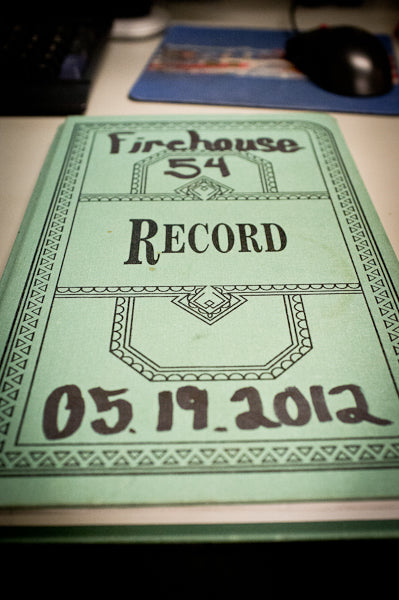
There wasn't a pause, a moment of silence, a last alarm, or even a mention of the tradition we killed in the name of efficiency. No one said a eulogy and no one rang a bell for the thousands of officers that had carefully documented everything that had happened on their watch at their station on any given day in Dade County. To think about the millions of calls our department has run in almost a hundred years is one thing. To see the volumes of logbooks that document every one of them is another.
Why was I so bothered by this change? Every other officer I talked to seemed thankful that this extra bit of work was being lifted from our shoulders. Don't get me wrong, at three o'clock in the morning there is no higher form of drudgery than sitting down and documenting some call that was anything but an emergency. Why, after five day, does this change still bother me? This was something that I had a hard time putting my head around. I'm certainly not a technology hater or a doomsday prepper. I have my iphone in my pocket. I'm on Facebook. I love having the TIC at my side going into a fire. And I'm sure the department has all of our documents secured on servers in fireproof rooms and virtual iclouds. Then it hit me.
Those logbooks--those documents written in so many different handwriting styles, are the only substantive evidence of the daily work we do. Those books are the only thing that you can pick up, feel, read, and see what that day--any day cost us. You can see it in the chicken scratch of tired officers or the careful letters of men who are not used to writing much more than their name. But most of all, you could walk in before your tour, run your finger down the column of calls and see if your brothers had a fire, a rough night, or if the gods were kind and let them sleep.
So this blog is not so much about blasting technology. It is more a warning to consider the things you leave behind in the name of efficiency.

What was lost today? Today I lost that moment in the morning when I sit with my coffee and write the names of each member of my company--that moment where I sit and consider their strengths and weaknesses and how I will use them in different situations. Sure I will still do this. I'll just have to find another way. And for me, writing these names was a reminder to myself, a contract that I am beholden to that states that I'm responsible for the safety of each firefighter at my station. If you don't believe me you can look for yourself and see it written in black and white on the page.
There isn't a blinking screen in the world that can provide that same feeling.
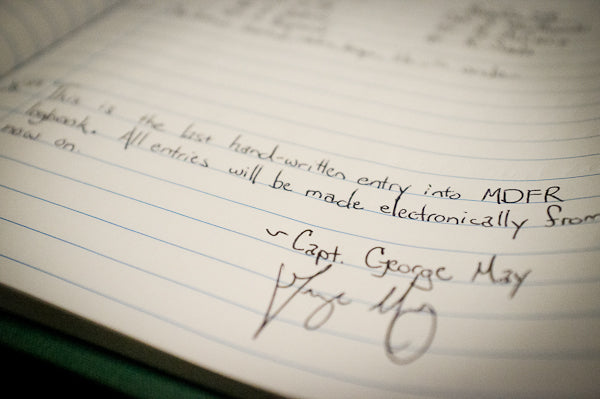
Pay It Forward September 20 2012, 0 Comments
Hook and Irons Co. was born with one philosophy, pay it forward. Our idea was simple; we would help the fire service reconnect with its history using the tenets of early American craftsmanship to build our apparel line. Through meaningful, simple designs, we are creating shirts that are more than shirts, they are historical threads and conversation pieces. Whether you are active, retired, volunteer or just someone who loves the spirit of the American fire service, we want you to feel proud wearing our clothing. Firefighter or not, being a part of the brotherhood is as simple as knowing where we, as Americans come from and honoring that feeling everyday of our lives.
Recently, we received an e-mail that made us proud and re-affirmed our belief in the Hook & Irons project:
" Thank you for making something that makes me feel like I'm still part of the brotherhood. I spent 10 years as a volunteer helping other people because of things I witnessed in my youth. I was not motivated by the paycheck but doing my part of being a responsible human being.
When my time with the fire service was done, I felt like I was on the outside. Sometimes hearing the comments from active firefighters has been very disheartening.
Then one day something happened. I was walking through a store and a young man walked up to me and said, " You don't remember me but you saved my life. At that moment every sore muscle and sleepless night I had on the job was worth it. I do remember you Eddie! I told him. Never in my life did I ever feel so humbled. God saved Eddie that day, I was the tool he used.
-Paul
Paul served on Engine 7474 as a firefighter / EMT at Coloma Lotus Volunteer Fire Department California 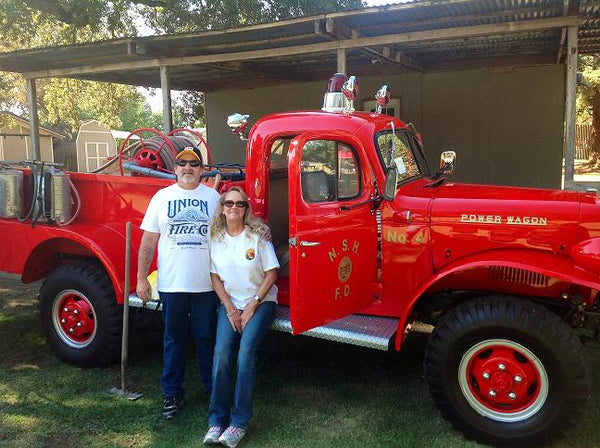
Richie Stewart and the Social Club September 08 2012, 3 Comments
In the early 1800's middle class Gentlemens Clubs were popular in most major cities. These were later referred to as Social Clubs. It was a place where people would escape everyday life and could meet, drink and tell stories. It wasn't uncommon to see patrons playing bar games, listening to live music or enjoying a fine rolled cigar. Modern day social clubs have evolved over the years.The original concept has slowly become what we know today as our favorite watering hole. After a long tour of duty, these bars are commonly filled with firemen telling war stories or laughing over the pranks they played on the new guy. These are the times when we celebrate the brotherhood of the fire service.
While researching photos and the history of the fire service we came up with the idea to create our own Social Club. We wanted to have an outlet where our fans could come together to celebrate the fire service and it's traditions. A band of brothers who cherish the history of the fire service and want to carry on its legacy. We want the Hook and Irons Social Club to be there when the bag pipes are filling the streets and when the bartender rings the bell for the last call.
When we set out to create the Social Club, we had one artist in mind. Richie Stewart.

We pitched him the idea and he immediately jumped on board. You see, Richie lives in Boston,one of the epicenters of early American Social Clubs, where he is no stranger to a tall glass of golden goodness. We looked through his logos and agreed on a concept; simple, clean and bold. He took his inspiration from catalogs of old Americana union logos, and a few weeks later he sent us this gem.

The bold typography and his artistic renderings of a drop of water and a lick fire represent "firewater" perfectly. We love the double meaning. Finally, Richie rounded out the design with a smoldering cigar. Richie Stewart's art is unmistakable and timeless, if your interested in seeing more of his retro inspired work, click here.
With the logo complete, the Hook and Irons Social Club has come to life. We invite you to proudly wear the seal of what Hook and Irons Co. represents. There is a lot more to come from the Social Club. Until then, like us on Facebook so you can share a pint with us at our next gathering.
Ben Franklin Was Here September 08 2012, 0 Comments
When creating the Signature Line, we decided to begin at the beginning of the American fire service. We wanted to create a shirt that honored Benjamin Franklin; the man whose ideas and articles envisioned and called for what would become the fire service that we know today. On December 7th, 1736, he and four friends founded the Union Fire Company. This was the first fire department that was started independently to serve anyone who needed fire protection. Prior to the Union Fire Co. fire brigades were run by large insurance companies to protect their own clients.

The Union Fire Co., which survives today as Engine 8 of the Philadelphia Fire Department is one of the oldest organized fire brigades in the United States. When the Union was formed it saw its ranks quickly filled to the agreed-upon maximum of 30 members. After that, latecomers were urged to start their own fire brigades thereby increasing the fire protection and coverage throughout the city. Within a short amount of time many new brigades sprung up with names like Heart-in-Hand, the Britannia, and the Fellowship. To belong to one of these companies was a mark of honor and sign of devotion to your fellow man and community. George Washington, for example, was a member of his local volunteer fire company in Alexandria, Virginia.
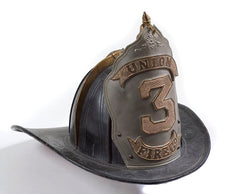
It was with this thought that we wanted to pay homage to Ben Franklin and his thought that, "an ounce of prevention is worth a pound of cure." Without his activism, the fire service might look very different than it does today.


This is our first offering in our Signature Line. We hope you like it. We put a lot of thought and research into creating this limited edition shirt. Our goal was to make something we think Ben Franklin himself would've worn. Put some meaning into what you wear and come celebrate our history.
This shirt was farmed, milled, manufactured and printed in the USA.
The Eagle Has Landed September 08 2012, 2 Comments
When we sat down with Tom Lane to come up with the Hook & Irons symbol, we threw around a bunch of ideas for our version of the 'Nike Swoosh', but nothing ever beat out the eagle--that proud iconic presence that sits atop most of our helmets. After doing some research on the eagle's history, we took some photographs of the eagles on our own helmets and turned them over to Tom.

The origin of the eagle on the modern fire helmet can be traced to around 1825 when an unknown sculptor created a commemorative figure for the grave of a volunteer firefighter. The figure on the grave was that of a firefighter, emerging from flames holding a sleeping child in one hand and a trumpet in the other. The figure wore a helmet with an eagle on it, which soon became part of the helmets worn by firefighters to this day.
Even though the eagle's practicality is often questioned and technology has devised better ways of affixing a firefighters unit designation to their helmet, this is one battle that time and technology has not won--yet. And we love that.
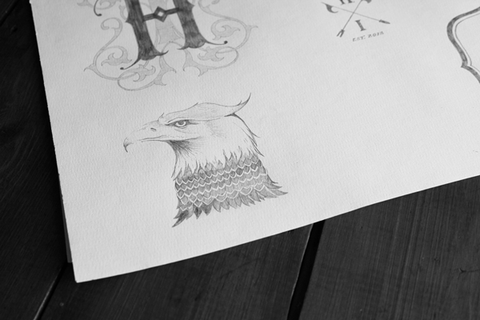
The Hook & Irons eagle was hand-drawn, painstakingly sketched and then inked. Our design was built by hand, embodying everything that is great about the fire service--everything we fear that time and technology might one day change.
Til then, wear it with pride.

